Embark on a journey back in time with a luxurious Nile Dahabiya Cruise aboard the Nour El Nil’s Malouka Traditional Sailboat. This elegant vessel offers a unique and intimate way to experience the beauty and history of Egypt’s iconic Nile River. From the stunning views of ancient temples and bustling markets to the impeccable service and exquisite cuisine on board, this review will take you through all the highlights of a truly unforgettable 5-night cruising experience.
You can view our YouTube video of our time on Nour El Nil’s Malouka Dahabiya here

Why did we choose Nour El Nil’s Dahabiya sailboat Malouka?
Egypt has been a long-term travel bucket list experience for us. Part of that bucket list was a cruise from Esna to Aswan on board the traditional dahabiya sailboat. When we started to research our 3 week journey through Egypt there were so many choices of boats to choose from that departed Luxor for Aswan. The choices were small ship cruises, feluccas and dahabiyas.
The small ship cruises offer accommodation from 50 – 150 passengers. They will have restaurants, a swimming pool, a sun deck and nightly entertainment. Their air-conditioned cabins have ensuite bathrooms.
Feluccas can carry up to 10 passengers. There are no private cabins, you are given a mattress to sleep on deck under the stars. Some have installed toilets, but for those that haven’t, a support boat provides toilet and shower facilities and a kitchen to prepare meals.

Dahabiyas are two-masted beautiful sailing boats which sail the River Nile without an engine. Travelling beside the dahabiyas are support boats. When you are under sail it is magic, and calm, all you hear is the waves gently lapping the side of the boat.
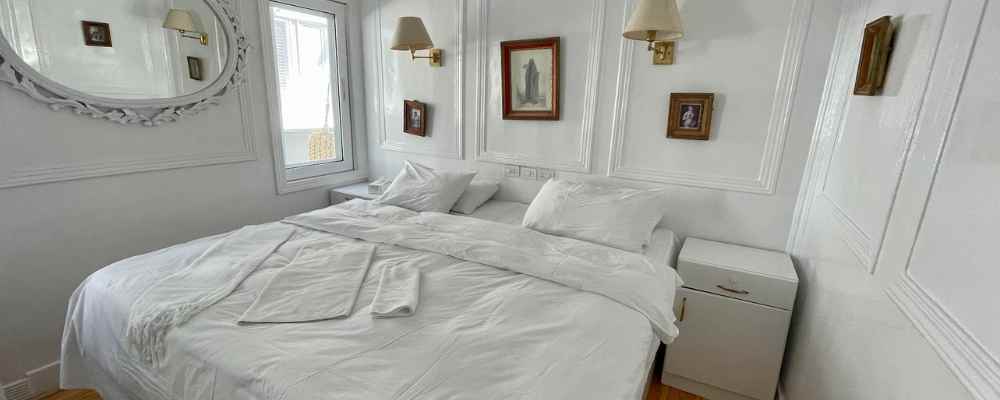
Nour el Nil have 7 luxury dahabiyas ranging in size from 37m to 59m. Our dahabiya, Malouka, at 52m, had two panoramic cabins and 10 luxury rooms all with ensuites. The luxury rooms offer either a king-size bed or twin bed configurations. The bedrooms and library are located on the bottom deck. There was so much to see whilst sailing and the weather was perfect during our voyage that the library did not get much use at all. The price range was mid-way for the Makouka. There are only a maximum of 20 guests per boat.
As the boats are smaller than the river cruise ships they can go where the bigger vessels can’t.
We chose Nour el Nil because of their experience and excellent reviews. The itinerary was for 5 five-night sailing from Esna 33 miles south of Luxor to Aswan. The itinerary was different each day visiting temples and small villages with the opportunity to swim in the Nile. During the day when we were sailing we spent our time reading, relaxing, and chatting with the other guests.

The top deck is expansive with a range of comfortable lounge seating and a dining table where we all sat family-style under a covered canvas tent.
This post may contain affiliate links. Please see our disclosure for more information. As an Amazon Associate, we earn from qualifying purchases (if applicable).
Meals on Board Nour El Nil’s Malouka
Coffee and tea were available before breakfast up on the deck each morning.

A typical breakfast would consist of crepes, jam, bread, fruit, cheese, eggs made to order, tea, coffee and juice.
If we were on board during mid-morning tea and coffee were available. Sometimes we had cake and other times fruit or biscuits.

Lunch and dinner varied daily with local Egyptian specialities for meat eaters and vegetarians.
Fresh Nile Perch was on the menu during the voyage. This was a favourite of most of the guests. The chef made excellent vegetable soups too! We mostly drank the local Egyptian beer – Sakkara but you could have wine and cocktails too. The crew will keep a tab and advise you of your alcoholic expenses on the last night.

Our 5-night/6 day itinerary on Nour El Nil’s Malouka
Day 1 Esna
Nour el Nil’s departures from Esna are on a Monday.
We were staying at the Pavillon Winter Palace in Luxor on the last night of our 4-night stay there. The previous 3 nights we enjoyed our stay at the Sofitel Winter Palace in Luxor.
Our bus arrived around 9 and we boarded with passengers who had all booked different dahabiyas with Nour El Nil. We would catch up with them on some of our temple tours during the week.

It took us around an hour to travel from Esna to Luxor. Before we boarded Malouka we visited the Temple of Khnum also known as the Temple of Esna which sits 9 m below street level. The 24 columns inside the temple are well-maintained and colourful in their hieroglyphic inscriptions. The Graeco-Roman temple was dedicated to the ram-headed god Khnum.
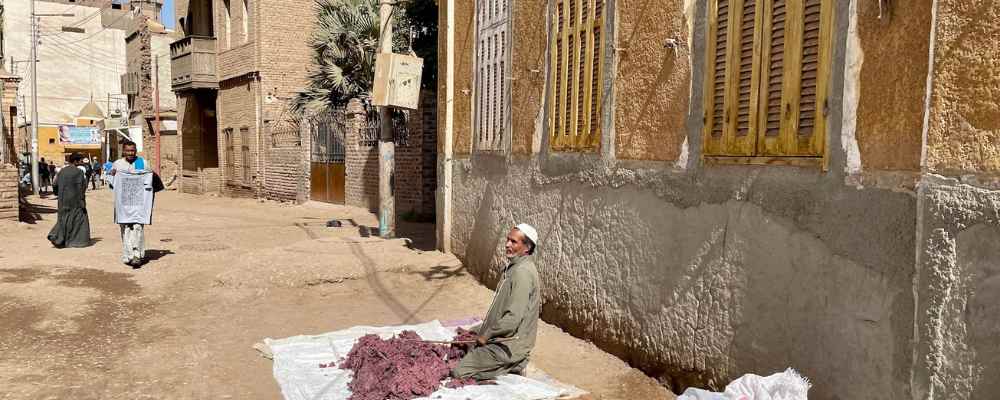
After visiting the temple we wandered through the colourful back streets of Esna before boarding our ship.
Once on board you can collect your luggage and choose which room you want, as they are offered on a first-come basis.
We were excited to join our fellow guests on the deck for lunch. The choice of dishes for lunch was exceptional, if our cruise continues like this we will both be over the moon. So delicious! We dined on tahini and local bread, vegetable soup, salads, local Nile Perch, chips and fruit.
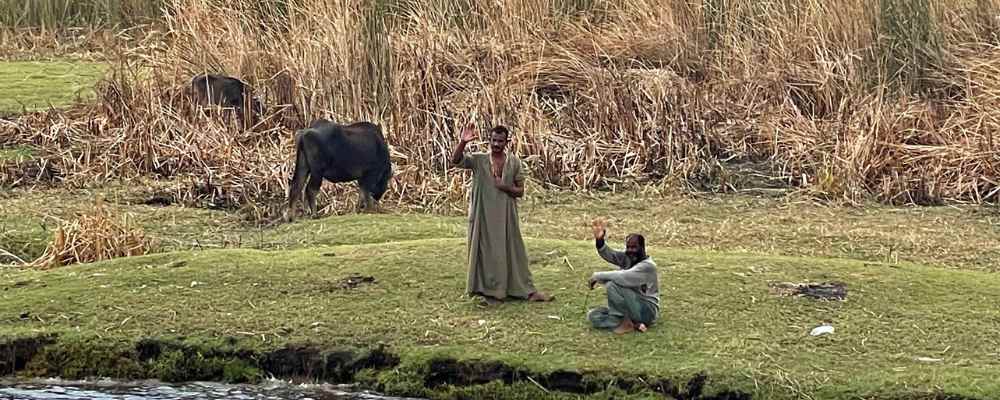
As we were under sail after lunch we sat back and enjoyed the scenery of the Egyptian countryside as we sailed by. Local fishermen in their small boats sailed by with their catch, we admired the Egyptian farmhouses and farm animals on the West Nile and sand dunes on the East Nile riverbanks.
As we docked in the late afternoon, children riding donkeys passed us laughing and cheering. We had an afternoon activity visiting a local village. Passing through fields of cane and fruit trees and crossing the canal we arrived at the small village. One family allowed us to visit their home, taking a look inside their bedrooms and learning about their kitchen facilities. We thanked them for their hospitality and wandered back at sunset to the boat where dinner awaited us.

Day 2 Visit to El Kab and Edfu

After a breakfast of fresh bread, crepes, local jam, fruit, fruit juice and eggs any way you wanted, we sat back with our coffee and mint tea and sailed to our next destination El Kab on the East bank of the Nile. Minibuses awaited to take us to El Kab.
The El Kab complex is a set of rock-cut tombs from 1550–1295 BC.
A short walk up the hill to the impressive Tomb of Paheri. The Tomb of Paheri contains colourful scenes of family banquets, farming, livestock, fishing practices and ritual activities. Paheri was the Mayor of Nekheb.
The Tomb of Setau – Setau was the High Priest during the reign of Ramses III and Ramses IV. Although some of the walls are severely damaged others show colourful reliefs depict family offerings.
The Tomb of Ahmose depicts his part in the war at the beginning of the New Kingdom.
The Tomb of Reneni depicts the women in mourning and Egyptian funeral rites.
Our guide Ahmed (Saffy) was very knowledgeable. Ahmed was our guide for the rest of our temple tours along our journey to Aswan.
Good to know: ensure that you have comfortable walking shoes, a hat, wear sunscreen and take water with you.
We headed back to Malouka for lunch. The menu again was varied, cheese pastries, local breads, salads and hot vegetable dishes.
After a short sail we arrived at Edfu. There were many river cruise boats there plus the flotila of Nour El Nil. Our journey to Edfu Temple was by horse and cart.
Good to know: Remember your carriage number as this will be the same carriage which you will return on. Your driver will expect a tip.
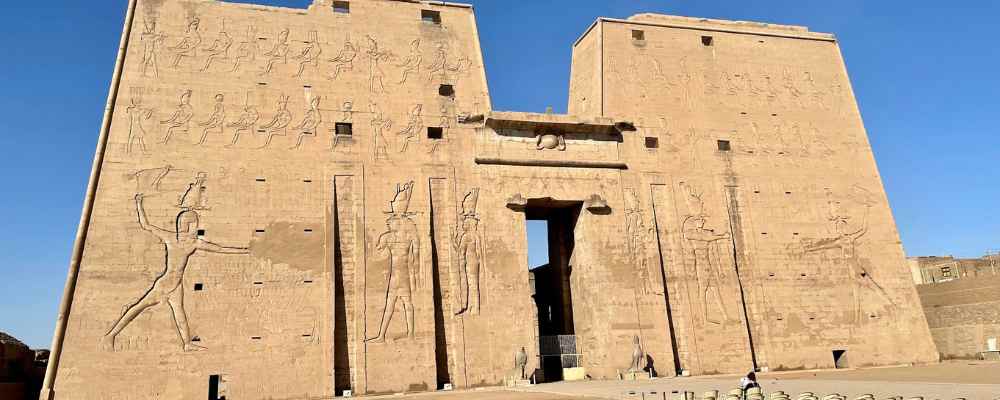
Edfu is located 115 km south of Luxor and 104 km north of Aswan. The Temple of Horus at Edfu was buried under sand for nearly 2000 years and is one of the most preserved temples. Construction began in 237 BC under the reign of Ptolemy III and was eventually completed 180 years in the reign of Ptolemy XII in 57 BC. It was discovered in 1860 by the French Archaeologist Auguste Mariette.
The gates are made from cedar wood from Babylon, the door is made from gold, bronze and silver. The first pylon stands 36m high. Statues of the falcon God Horus stand at the entrance, they are constructed from black granite.
Day 3 Sail & swim and a late afternoon walk

Our morning was spent leisurely sailing the River Nile. Before lunch we stopped at a small island where those who were brave enough enjoyed a swim. The current is very fast and some of the crew will come with you to keep an eye on your. Life buoys are thrown out for those are not competent swimmers. Those who did swim loved the experience.

Late afternoon we arrived at our next stop – the Temple of Gebel Silsileh which we would be visiting the next morning. We headed away from the boat for a late afternoon walk through a local village to one of the high points for views over the River Nile.
Day 4 Visit Gebel Silsileh

The River Nile is the narrowest here as it flows between the two mountain ranges. The beauty of the dahabiyas is that they can visit the site as the larger river cruises cannot.
Gebel Silsileh consist of sandstone quaries used from the Middle Kingdom (c2034-1650BC) until the 20th Century to construct Egypt’s famous temples. There were once 104 queries, 52 located either side of the Nile.
There were once 2 temples here on this site but only 1 has survived. It is known as the Speos of Horemheb.

As we wandered down towards the Quarries Ahmed pointed our three stelaes on the rock face facing East across the Nile. The first one dedicated to Ramses V (1147-1143BC) showing the King presenting his Throne Name to the God Amun-Ra, his wife Mut and their son Khon-Su and the crocodile God Sobek.
The 2nd stelae is dedicated by Sheshonqi (c945-924BC) it shows the Goddess Mut leading the King to the Gods Amun-Ra, Ra-Horakhy and Ptah.
The 3rd stelae was made by King Ramses III (c1184-1153BC). It shows the King presenting a figure of Maat, the Goddess of Order and Justice, to Amun-Ra, Mut and Khonsu.
The Alabaster Quarry was a holy site where 8 million stones were cut. 13,000 people worked in the quarries.

The Speos of Horemheb was built in a cave during the reign. of Horemeb (1323 – 1295 BC), he was the last King of the 18th Dynasty. 5 openings were cut into the cliff separated by pillars. Inside you can see rock-cut statues of the 7 Gods – Sobek, Taweret, King Horemheb, Amun-Ra, Mut and Khonsu.
After a very tasty lunch we settle down to relax and read before there was another opportunity for a swim in the Nile. This time the support boat took those who were keen further down the Nile so that they could swim or float back, whatever took their fancy.
After sailing a short distance we pulled up in the East Bank and the chef prepared a BBQ for us.
Day 5 Kom Ombo
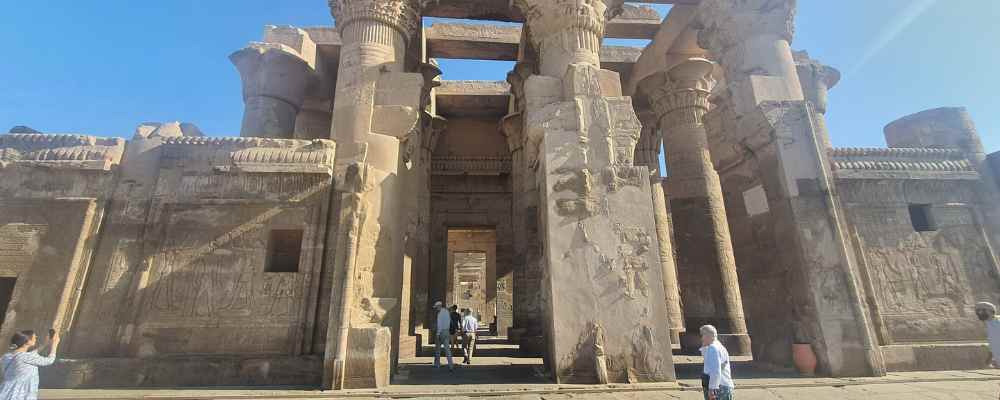
A short sail and we arrive at the town and temple of Kom Ombo. Aswan is still 40 km away at this stage. The Temple is located on the bend of the River Nile in a stunning location.
As we went ashore there were many souvenir sellers with ceramics, alabaster, rugs, clothing etc. If you are not interested just say so and walk on. They can pressure you if you take an interest.
Kom Ombo Temple is a Graeco-Roman temple with two entrances, two halls and two sanctuaries. The left side of the Temple is dedicated to Horus the Elder (falcon-god Haroeris) and on the right side to Sobek the crocodile God. The construction started in the 2nd century BC under the reign of Ptolemy VI and completed during the 1st century BC by Ptolemy XII.
We found many of the scenes depicted on the walls interesting e.g. The Surgical Instruments Scene of scapels, forceps, hooks, scales, sponges etc.
The Chapel of the Hearing Ear was constructed so people can pray to their God.
Kom Ombo also has an Egyptian festival calendar inscription. The calendar shows 3 seasons of 4 months. It also shows the time of the flood, cultivation and harvest.
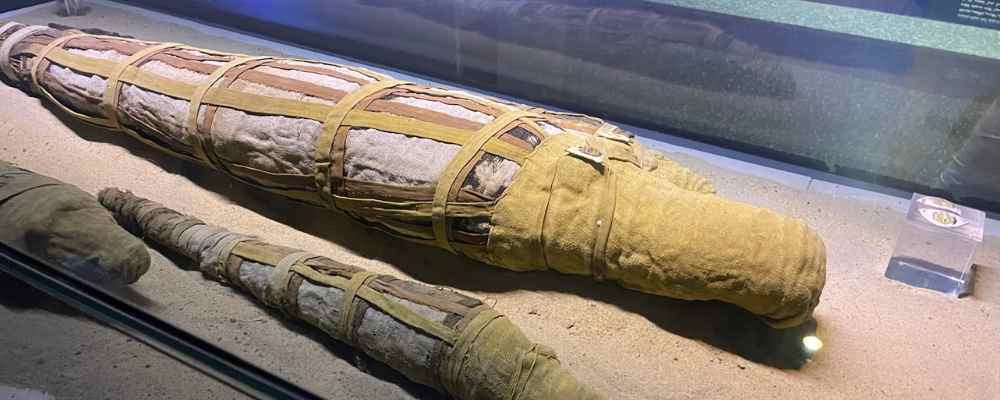
As you exit the site there is a Crocodile Museum which houses 40 crocodile mummies.
The rest of our last day is spent relaxing and chatting to the guests before our final dinner that evening. We don’t dock in Aswan but just before Aswan Bridge. It is not as scenic as other locations but the Government has made it a legal requirement.
Day 6 Aswan

A sad day for all as we enjoy our last breakfast, say goodbye to our new friends and board our buses to our accommodation.
We chose to spend the next two nights at the Old Cataract Hotel. Our tours included a visit to Aswan Botanical Gardens, Saint Simeon Monastery, a Nubian Village and Philae Temple. You can read our guide on 2 days in Aswan here. After our time in Aswan we had a driver to take us to Abu Simbel for 2 nights staying at the Seti Abu Simbel.
Conclusion

If you want to see the best of Egyptian life a dahabiya cruise on the Nile is for you. The crew on board Malouka became our family for the 6 days. We learnt much of their life and their families and their history. It was hard to say goodbye to them. We have made life long friends with the other passengers who came from all walks of life and different age groups.
The meals were the best we had in Egypt. We felt relaxed and rejuvenated after a couple of hectic weeks sightseeing.
Nour el Nil is one of the expensive dahabiyas plying the Nile River. Was it worth the extra? Yes, it was. There is not one thing I would change.
General Travel Information Egypt
To book your Nour El Nil cruise – click here
For the latest flight deals to Egypt click here
For travel around Egypt by bus click here
Need an e-sim for Egypt – more details here.
We had great coverage with our Holafly e-sim even in the middle of the desert between Aswan and Abu Simbel.
Visas for Egypt
Depending on what passport you hold you can either get a visa on arrival at major Egyptian airports. There is another option using the services of a visa company which tend to be more expensive.
Details here:
Need some new travel clothes or luggage?
Travel smarter and safer with products from our To Travel Too Travel Shop. If you are looking for the latest luggage, guidebooks or travel accessories we have you covered with over 800 travel products to choose from.
Travel Insurance
World Nomads offers simple and flexible travel insurance. Buy at home or while travelling and claim online from anywhere in the world.
Accommodation
Need accommodation in Aswan on arrival? Check out the latest deals on Booking.com here.
Are you on Pinterest? We are at To Travel Too and we have many travel-related boards check us out at Pinterest. If you enjoyed our article why not pin it to your board and read it later?

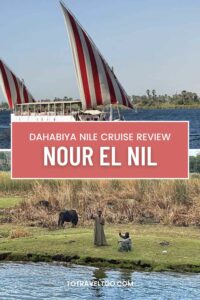


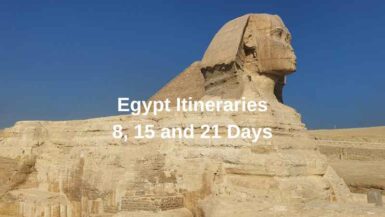
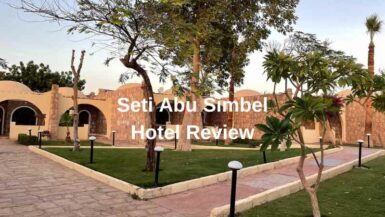

Leave a reply